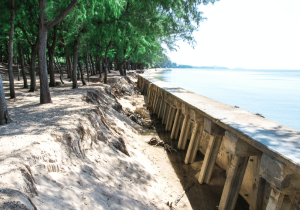In the winter, when temperatures drop and ice begins to form on rivers and lakes, your seawall is at risk. Ice can pile up on your seawall, putting pressure on the structure and eventually causing it to fail. There are things you can do to protect your seawall from ice damage. In this post, we’ll share some tips on how to stop ice from damaging your seawall.
The dangers of ice on your seawall
 Snow and ice around your seawall can be very dangerous. Ice can slowly break down the integrity of your seawall, making it less able to protect your property from rising water levels in winter months. Warmer seasons bring thawing, which can cause cracks and other structural damage due to the expansion of water. It’s important to understand how to protect your seawall from these natural forces so you avoid having to pay for expensive repairs down the line. Thankfully, there are easy ways to safeguard against future deterioration, including proper maintenance and insulation. Taking the steps now will save you time, energy, and money in the long-term!
Snow and ice around your seawall can be very dangerous. Ice can slowly break down the integrity of your seawall, making it less able to protect your property from rising water levels in winter months. Warmer seasons bring thawing, which can cause cracks and other structural damage due to the expansion of water. It’s important to understand how to protect your seawall from these natural forces so you avoid having to pay for expensive repairs down the line. Thankfully, there are easy ways to safeguard against future deterioration, including proper maintenance and insulation. Taking the steps now will save you time, energy, and money in the long-term!
How to prevent ice buildup
Ice buildup along your seawall can cause serious damage and disrupt the safety of your seaside residence if not properly managed. The good news is there are ways to prevent both large and small accumulations of ice from forming, including regularly removing loose snow from around your property, strategically placing barriers to slow down shifting ice flows, and breaking up ice throughout the winter with ladders or heavy-duty picks. Additionally, investing in a deicer salt may prove beneficial in reducing any possible future complications. With proper preventative measures, you can ensure peace of mind when it comes to the stability of your seafront weapons against the forces of winter.
How to remove ice from your seawall safely
 Winter’s cold can cause serious problems to your seawall, as ice can easily accumulate when temperatures drop. Removing ice is essential and must be done safely in order to prevent damage or injury. To accomplish this, the best approach is to slowly chip away the large chunks of frozen accumulation away from the wall. This strategy will minimize any impact that harsh ice removal methods may have on corroded fixings or masonry. Furthermore, if accumulated snow starts to melt during warm days, you should use a tool like a rake or broom to remove it quickly—before water refreezes and builds up even more layers of ice. Doing so can give you peace of mind throughout the winter season, knowing that your seawall is well-protected from potential damage caused by frigid temperatures.
Winter’s cold can cause serious problems to your seawall, as ice can easily accumulate when temperatures drop. Removing ice is essential and must be done safely in order to prevent damage or injury. To accomplish this, the best approach is to slowly chip away the large chunks of frozen accumulation away from the wall. This strategy will minimize any impact that harsh ice removal methods may have on corroded fixings or masonry. Furthermore, if accumulated snow starts to melt during warm days, you should use a tool like a rake or broom to remove it quickly—before water refreezes and builds up even more layers of ice. Doing so can give you peace of mind throughout the winter season, knowing that your seawall is well-protected from potential damage caused by frigid temperatures.
Ice buildup on your seawall can be extremely dangerous, but there are thankfully preventative measures you can take to stop it before it becomes a problem. If you do end up with ice on your seawall, never try to remove it yourself – always call in professional help to avoid damaging your property or putting yourself in danger.